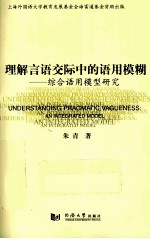

理解言语交际中的语用模糊 综合语用模型研究PDF电子书下载
- 电子书积分:10 积分如何计算积分?
- 作 者:朱青著
- 出 版 社:上海:同济大学出版社
- 出版年份:2010
- ISBN:9787560843766
- 页数:233 页
Chapter One Introduction 1
1.1 Object of the research 1
1.2 Rationale for the research 5
1.3 Significance of the research 8
1.4 Methodology and data 9
1.5 Organization of the book 9
Chapter Two An Overview of Approaches to Vagueness 11
2.1 Introduction 11
2.2 Etymology of"vague" 12
2.3 Vagueness and the Sorites Paradox:a historical survey 14
2.4 The philosophical approach to vagueness 18
2.5 The semantic approach to vagueness 25
2.5.1 Vagueness,ambiguity,generality and epistemic failure 25
2.5.2 Definition of vagueness 32
2.6 The cognitive approach to vagueness 34
2.7 Summary 38
Chapter Three Pragmatic Vagueness 39
3.1 Introduction 39
3.2 The pragmatic vagueness/semantic vagueness distinction 39
3.2.1 The pragmatics/semantics distinction 40
3.2.2 Pragmatic vagueness versus semantic vagueness 47
3.3 A taxonomy of pragmatic vagueness 59
3.3.1 Quality-based pragmatic vagueness 62
3.3.2 Quantity-based pragmatic vagueness 66
3.3.3 Relation-based pragmatic vagueness 71
3.4 Functions of pragmatic vagueness 73
3.5 Summary 77
Chapter Four A Review of the Pragmatic Literature on Verbal Communication 79
4.1 Introduction 79
4.2 Grice's co-operative principle 80
4.2.1 The conversational maxims of co-operative principle 81
4.2.2 Observance of the conversational maxims 84
4.2.3 Nonobservance of the conversational maxims 86
4.3 Adaptation theory 93
4.3.1 Verschueren's interdisciplinary perspective on language use 95
4.3.2 Perspective view of language 97
4.3.3 Linguistic choice-making and its key notions 99
4.3.4 Four angles of pragmatic investigation 109
4.3.5 Metapragmatic awareness 118
4.3.6 Strengths and weaknesses of adaptation theory 119
4.4 Relevance theory 121
4.4.1 Two models of communication 122
4.4.2 Relevance 125
4.4.3 Explicature 131
4.4.4 Implicature in relevance theory 138
4.5 Summary 140
Chapter Five The CRAP Model for Explaining Pragmatic Vagueness 142
5.1 Introduction 142
5.2 An overview of the CRAP model 144
5.2.1 The CRAP model and its precursors 144
5.2.2 Constituents of the CRAP model 156
5.3 The CRAP model:the production of pragmatically vague utterances 168
5.4 The CRAP model:the interpretation of pragmatically vague utterances 176
5.4.1 Mental structure as functional architecture:horizontal faculties 177
5.4.2 Mental structure as functional architecture:vertical faculties 179
5.4.3 Fodorian theory of cognitive modularity 184
5.4.4 Sperber and Wilson's position on the modularity of mind 188
5.4.5 The interpretation of pragmatic vagueness:a massively modular approach 192
5.5 Summary 207
Chapter Six Conclusion 210
6.1 Major findings of the research 210
6.2 Ramifications and implications 213
6.3 Limitations of the research and suggestions for further work 216
References 218
- 《大学英语教学的跨文化交际视角研究与创新发展》许丽云,刘枫,尚利明著 2020
- 《跨文化交际背景下的中西文化比较研究》任永进,贺志涛著 2019
- 《模型与认知》(美)乔纳森·A.瓦斯肯著,魏刘伟译 2019
- 《现代汉语语用否定研究》王志英 2019
- 《中国二氧化碳减排和环境协同效益评价模型的构建与研究》杨曦,滕飞著 2019
- 《计算机自适应英语语用能力测试系统设计与效度验证 以TEM4词汇与语法题为例》张一鑫著 2019
- 《高中压配电网规划 实用模型、方法、软件和应用 上》王主丁著 2020
- 《初等模型论》姚宁远著 2018
- 《数学模型在生态学的应用及研究 42》鹿源责任编辑;杨东方,李烨 2018
- 《跨文化交际学基础导论》林大津,尤泽顺导读 2007
